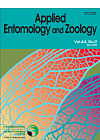Volume 40, Issue 3
Displaying 1-21 of 21 articles from this issue
- |<
- <
- 1
- >
- >|
Regular Papers
-
2005 Volume 40 Issue 3 Pages 387-390
Published: 2005
Released on J-STAGE: November 25, 2005
Download PDF (94K) -
2005 Volume 40 Issue 3 Pages 391-397
Published: 2005
Released on J-STAGE: November 25, 2005
Download PDF (173K) -
2005 Volume 40 Issue 3 Pages 399-404
Published: 2005
Released on J-STAGE: November 25, 2005
Download PDF (243K) -
2005 Volume 40 Issue 3 Pages 405-412
Published: 2005
Released on J-STAGE: November 25, 2005
Download PDF (371K) -
2005 Volume 40 Issue 3 Pages 413-420
Published: 2005
Released on J-STAGE: November 25, 2005
Download PDF (387K) -
2005 Volume 40 Issue 3 Pages 421-427
Published: 2005
Released on J-STAGE: November 25, 2005
Download PDF (447K) -
2005 Volume 40 Issue 3 Pages 429-435
Published: 2005
Released on J-STAGE: November 25, 2005
Download PDF (126K) -
2005 Volume 40 Issue 3 Pages 437-446
Published: 2005
Released on J-STAGE: November 25, 2005
Download PDF (516K) -
2005 Volume 40 Issue 3 Pages 447-456
Published: 2005
Released on J-STAGE: November 25, 2005
Download PDF (1271K) -
2005 Volume 40 Issue 3 Pages 457-460
Published: 2005
Released on J-STAGE: November 25, 2005
Download PDF (277K) -
2005 Volume 40 Issue 3 Pages 461-466
Published: 2005
Released on J-STAGE: November 25, 2005
Download PDF (179K) -
2005 Volume 40 Issue 3 Pages 467-474
Published: 2005
Released on J-STAGE: November 25, 2005
Download PDF (425K) -
2005 Volume 40 Issue 3 Pages 475-482
Published: 2005
Released on J-STAGE: November 25, 2005
Download PDF (96K) -
2005 Volume 40 Issue 3 Pages 483-488
Published: 2005
Released on J-STAGE: November 25, 2005
Download PDF (206K) -
2005 Volume 40 Issue 3 Pages 489-495
Published: 2005
Released on J-STAGE: November 25, 2005
Download PDF (68K) -
2005 Volume 40 Issue 3 Pages 497-505
Published: 2005
Released on J-STAGE: November 25, 2005
Download PDF (983K) -
2005 Volume 40 Issue 3 Pages 507-511
Published: 2005
Released on J-STAGE: November 25, 2005
Download PDF (575K) -
2005 Volume 40 Issue 3 Pages 513-519
Published: 2005
Released on J-STAGE: November 25, 2005
Download PDF (264K) -
2005 Volume 40 Issue 3 Pages 521-527
Published: 2005
Released on J-STAGE: November 25, 2005
Download PDF (107K) -
2005 Volume 40 Issue 3 Pages 529-535
Published: 2005
Released on J-STAGE: November 25, 2005
Download PDF (397K) -
2005 Volume 40 Issue 3 Pages 537-543
Published: 2005
Released on J-STAGE: November 25, 2005
Download PDF (701K)
- |<
- <
- 1
- >
- >|
